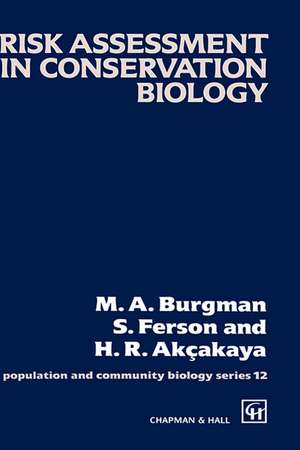Risk Assessment in Conservation Biology: Population and Community Biology Series, cartea 12
Autor M.A. Burgman, S. Ferson, H.R. Akçakayaen Limba Engleză Hardback – 31 ian 1993
Din seria Population and Community Biology Series
- 15%
 Preț: 646.11 lei
Preț: 646.11 lei - 18%
 Preț: 1224.54 lei
Preț: 1224.54 lei -
 Preț: 404.51 lei
Preț: 404.51 lei -
 Preț: 381.98 lei
Preț: 381.98 lei -
 Preț: 396.62 lei
Preț: 396.62 lei -
 Preț: 393.13 lei
Preț: 393.13 lei -
 Preț: 382.95 lei
Preț: 382.95 lei - 5%
 Preț: 373.47 lei
Preț: 373.47 lei - 18%
 Preț: 1221.38 lei
Preț: 1221.38 lei -
 Preț: 383.71 lei
Preț: 383.71 lei - 24%
 Preț: 1045.08 lei
Preț: 1045.08 lei - 24%
 Preț: 1033.06 lei
Preț: 1033.06 lei - 18%
 Preț: 1228.62 lei
Preț: 1228.62 lei - 18%
 Preț: 1546.05 lei
Preț: 1546.05 lei - 18%
 Preț: 959.98 lei
Preț: 959.98 lei - 18%
 Preț: 953.65 lei
Preț: 953.65 lei - 15%
 Preț: 635.80 lei
Preț: 635.80 lei - 18%
 Preț: 950.52 lei
Preț: 950.52 lei - 18%
 Preț: 834.17 lei
Preț: 834.17 lei - 15%
 Preț: 644.95 lei
Preț: 644.95 lei -
 Preț: 405.66 lei
Preț: 405.66 lei -
 Preț: 391.99 lei
Preț: 391.99 lei - 18%
 Preț: 1236.19 lei
Preț: 1236.19 lei - 15%
 Preț: 637.78 lei
Preț: 637.78 lei -
 Preț: 383.93 lei
Preț: 383.93 lei -
 Preț: 397.38 lei
Preț: 397.38 lei - 15%
 Preț: 640.06 lei
Preț: 640.06 lei
Preț: 1224.36 lei
Preț vechi: 1493.13 lei
-18% Nou
Puncte Express: 1837
Preț estimativ în valută:
234.28€ • 244.61$ • 193.90£
234.28€ • 244.61$ • 193.90£
Carte tipărită la comandă
Livrare economică 04-18 aprilie
Preluare comenzi: 021 569.72.76
Specificații
ISBN-13: 9780412350306
ISBN-10: 0412350300
Pagini: 314
Ilustrații: X, 314 p.
Dimensiuni: 155 x 235 x 19 mm
Greutate: 0.64 kg
Ediția:1993
Editura: SPRINGER NETHERLANDS
Colecția Springer
Seria Population and Community Biology Series
Locul publicării:Dordrecht, Netherlands
ISBN-10: 0412350300
Pagini: 314
Ilustrații: X, 314 p.
Dimensiuni: 155 x 235 x 19 mm
Greutate: 0.64 kg
Ediția:1993
Editura: SPRINGER NETHERLANDS
Colecția Springer
Seria Population and Community Biology Series
Locul publicării:Dordrecht, Netherlands
Public țintă
ResearchRecenzii
`...a book written by biologists for biologists...the accounts of the procedures are consistently well balanced and clear, with relevant biology.'
Biodiversity and Conservation
`[This] book will be found invaluable not only by conservation biologists, but by a much wider audience interested in the modeling of real populations. . . . I found the chapters on unstructured and age-structured models particularly enlightening, as they follow a clear path from theory to techniques to case studies. . . . This book is accessible to an unusually broad audience. Required is only `some familiarity with statistics, linear algebra and programming, or at least a lack of fear of these subjects' (right on!). Yet the biologically well-informed discussion of model selection and estimation, and of the limits of model interpretation, should make this book at least as useful to theoreticians in search of applicability as to empirical workers wishing to learn modeling. Plain language and clear examples prevail, yet the tone is never patronizing nor the message oversimplified.'
Trends in Ecology and Evolution
`...Well written and well organized. It provides a basic framework for those interested in population modeling, starting from simple models and gradually increasing their complexity; and shows how these models can be used to assess the risk of extinction of animal or plant populations... [It is] an excellent introduction to the use of mathematical models in conservation biology and risk assessment.'
Natural Resource Modeling
`...the author's style is clear and engaging....this imporatant book will appeal to a far wider audience than its title suggest, and could be profitably read bya wide range of ecologists and conservation biologists.'
The Quarterly Review of Biology
Biodiversity and Conservation
`[This] book will be found invaluable not only by conservation biologists, but by a much wider audience interested in the modeling of real populations. . . . I found the chapters on unstructured and age-structured models particularly enlightening, as they follow a clear path from theory to techniques to case studies. . . . This book is accessible to an unusually broad audience. Required is only `some familiarity with statistics, linear algebra and programming, or at least a lack of fear of these subjects' (right on!). Yet the biologically well-informed discussion of model selection and estimation, and of the limits of model interpretation, should make this book at least as useful to theoreticians in search of applicability as to empirical workers wishing to learn modeling. Plain language and clear examples prevail, yet the tone is never patronizing nor the message oversimplified.'
Trends in Ecology and Evolution
`...Well written and well organized. It provides a basic framework for those interested in population modeling, starting from simple models and gradually increasing their complexity; and shows how these models can be used to assess the risk of extinction of animal or plant populations... [It is] an excellent introduction to the use of mathematical models in conservation biology and risk assessment.'
Natural Resource Modeling
`...the author's style is clear and engaging....this imporatant book will appeal to a far wider audience than its title suggest, and could be profitably read bya wide range of ecologists and conservation biologists.'
The Quarterly Review of Biology












